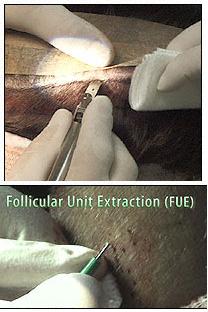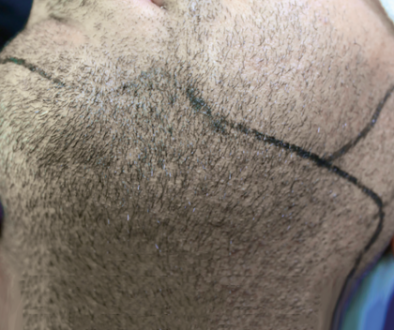Can Follicular Unit Extraction FUE and FUT Hair Transplant Surgery Peacefully Co-Exist?
 Since its inception in 2002, patients, physicians, and hair loss experts have debated the role of follicular unit extraction (FUE) in modern hair transplant surgery. Initially, various individuals were skeptical as many couldn’t help noting the similarities between FUE and the archaic multi-graft, “hair plug” extraction procedures of the past. Additionally, many leading hair restoration physicians today still don’t believe that the FUE method can match the success rate of modern follicular unit transplantation (FUT) via strip and microscopic dissection.
Since its inception in 2002, patients, physicians, and hair loss experts have debated the role of follicular unit extraction (FUE) in modern hair transplant surgery. Initially, various individuals were skeptical as many couldn’t help noting the similarities between FUE and the archaic multi-graft, “hair plug” extraction procedures of the past. Additionally, many leading hair restoration physicians today still don’t believe that the FUE method can match the success rate of modern follicular unit transplantation (FUT) via strip and microscopic dissection.
However, as follicular unit extraction (FUE) continues to advance and evolve, many are beginning to appreciate its merit and believe the procedure could serve a valuable purpose in the field of medical hair restoration. Additionally, as news of higher hair growth yield rates, precise extraction tools, and more cost effective methods continue to unfold, a greater number of patients and physicians are becoming receptive to undergoing and performing this procedure.
Although most hair restoration physicians and hair loss sufferers today maintain a neutral and logical opinion of FUE (believing it has a valuable purpose and acts as a good modality for certain patients), its rapid evolution, rise in popularity and hype surrounding the procedure has created a new, distinct division in the minds of various hair restoration patients and practitioners. One group continues to see FUE as an overhyped and under developed technique that could not match the “gold standard” set by modern follicular unit transplantation while another distinct sect of individuals sees FUE as the next logical step in surgical hair restoration and believes FUT is an overly invasive, outdated procedure. This continual debate unfortunately, often leaves hair loss suffering men and women researching surgical options confused and disillusioned.
The constant evolution of FUE combined with heated opinions both supporting and rejecting the procedure left these same patients and hair loss researchers with a series of unanswered questions. What are the benefits and limitations of each procedure? Are all hair loss sufferers candidates for follicular unit extraction? Which hair transplant procedure produces the best results? Can FUE and FUT peacefully co-exist?
Follicular Unit Transplantation (FUT) versus Follicular Unit Extraction (FUE)
Conventionally, most hair restoration experts tend to agree that ultra refined follicular unit hair transplantation is still the “gold standard” in hair restoration surgery. One of the most prevalent benefits of FUT is the fact that most androgenic alopecia sufferers are candidates for the procedure. The ability to excise and transplant a large number of grafts from a seemingly small portion of donor tissue makes the procedure an option for both men and women in various stages of genetic hair loss. Furthermore, thanks to the hard work of dedicated hair transplant surgeons, discounted FUT “mega sessions” featuring a single session of 2,500+ follicular unit grafts via microscopic dissection with minimal transection of valuable hair follicles are now becoming common practice. Thus, more patients are able to achieve their hair restoration goals in only one or two procedures at a reasonable cost.
Although there are many benefits associated with FUT, the procedure also possesses several limitations and potential problems. The most common of these, is the linear strip scar and the potential problems associated with improper healing and stretching. In the hands of a talented hair transplant surgeon, the resulting follicular unit transplantation scar can be “pencil thin” and nearly undetectable. However, if complications occur, wound closure is insufficient, or patient physiology is less than ideal, tissue “stretching” can occur and leave the surgical patient with a noticeable scar difficult to conceal wearing shortly cropped hair.
While improper healing is a rare but associated risk of both FUT and FUE, the scar stretching problem is non-existent with FUE. The lack of a linear scar and associated widening often makes FUE the more popular choice for men who’d rather wear their hair cropped short at the sides and back. Furthermore, the lack of wound closure and reduced trauma in the donor region equates to less recovery time and post-operative activity restriction.
But can FUE really produce the kinds of impressive results that “gold standard” ultra refined follicular unit hair transplantation?
Although FUE is gaining the ability to treat a wider variety of hair loss sufferers thanks to dedicated FUE practitioners and innovators in the field, many leading hair restoration physicians still feel that FUE is strictly limited to patients requiring a smaller number of grafts. Furthermore, while many leading FUE practitioners claim that follicular transection (irreparable damage a hair follicle hindering its ability to produce and grow healthy hairs) is minimal at their clinic, FUE’s “blind dissection” of hair follicles makes transection rates less predictable than with FUT and will vary in patients depending on their scalp/hair characteristics.
However, as FUE tools continue evolving, many surgeons believe larger cases will no longer be limited to the FUT technique. According to recommended hair transplant surgeon and FUE expert Dr. James Harris, new motorized FUE extraction devices, such as the Powered SAFE Scribe developed by Dr. Harris himself, allows extraction rates of up to 500-700 grafts per hour with transection rates equivalent to those in FUT cases of similar size. As physicians continue to evolve this technique, it’s possible that the “FUE megasession” (2,500+ grafts extracted and implanted in a single day via FUE) may become more of a reality.
But like FUT, donor hair is limited and extracting too many follicles in a concentrated area will produce an unnatural “moth-eaten” look. Thus, hair transplant surgeons must be as methodical and artistic during the donor hair extraction process as they are in making recipient sites for transplanting hair that mimics nature.
For more information on the kinds of session sizes, tools and results are being used and produced using today’s modern follicular unit extraction today including its benefits and limitations, visit the “Highlights of the 2010 Annual ISHRS Scientific Meeting in Boston, Massachusetts” and read the section on “The Advantages, Limitations and Refinements in FUE, its tools and Techniques”.
Due to the extra time, training, and resources inherent in the FUE procedure, even though they’ve come down somewhat over the years, FUE costs are still far greater than FUT to the prospective patient. Moreover, because many innovative FUE extraction devices and machines come with a hefty price tag, some physicians who purchase and incorporate these machines regularly into their practice have increased costs of FUE to offset their own overhead.
Promotional Propaganda and Hype Surrounding FUE to Avoid
New and revolutionary tools and devices, including semi-automated hair transplant machines (such as the ARTAS Hair Restoration System and NeoGraft Hair Transplant Machine) have stirred a lot of excitement and controversy amongst patients and physicians alike over the last couple of years. While these innovations are impressive, some marketing giants have wrongfully mass marketed their devices to the neophyte surgeon and technician, claiming that the machine itself can replace the need for highly skilled and experienced professionals. Since no automated device or machine can adapt or make critical decisions during an FUE procedure, there is major concern that many patients who undergo surgery with an untrained physician or technicians only using one of these devices will be left with poor results.
Thus, hair loss sufferers considering FUE should choose surgeons based on a proven consistency in providing their patients with excellent results, ethical behavior and a high standard of patient care. New and improved extraction tools and devices can aid physicians and their staff in providing patients with the best results, but even the most innovative and expensive tool in neophyte hands can be disastrous.
Furthermore, FUE has been wrongfully marketed as a “scarless” procedure. While FUE doesn’t produce the typical linear scar traditionally associated with FUT strip procedures, each extracted follicular unit is replaced by a tiny scar. If done right however, these scars are typically very well concealed by existing hair even at short lengths.
Can FUT and FUE Peacefully Co-Exist?
The continual evolution of FUE is exciting as it continues to provide hair loss sufferers with even more options. However, both hair transplant procedures (FUT and FUE) come with their own unique set of benefits, limitations and potential problems. Additionally, most leading hair transplant surgeons claim that there is no such thing as a “one size fits all hair transplant”. Thus, while the FUE procedure may always be optimal for one patient, FUT may always be better suited for another. Additionally, some hair loss sufferers with advanced baldness have and continue to benefit from a combination of both procedures in order to restore a maximum amount of hair.
Bill and Blake, Managing Publisher and Editorial Assistant for Hair Transplant Network, the Hair Loss Learning Center, the Hair Loss Q&A Blog and the Hair Loss Forum and Social Community
Technorati Tags: hair loss, follicular unit extraction, FUE, hair transplant surgery, follicular unit transplantation, FUT, medical hair restoration, hair restoration physicians, hair loss sufferers, Follicular Unit Transplantation (FUT) versus Follicular Unit Extraction (FUE), ultra refined follicular unit hair transplantation, hair restoration surgery, androgenic alopecia, mega sessions, hair follicles, linear strip scar, hair transplant surgeon, follicular unit transplantation, follicular unit hair transplantation, motorized FUE extraction devices, FUE megasession, FUE procedure, semi-automated hair transplant machines, ARTAS Hair Restoration System, NeoGraft Hair Transplant Machine




July 28, 2011 @ 12:35 am
I had a breast augmentation and tummy tuck Surgery hair transplant in india done. I feel AMAZING! I’m so excited about the results and how I feel. I was concerned about pain and recovery time and I can’t emphasize enough how easy and pain free the recovery has been